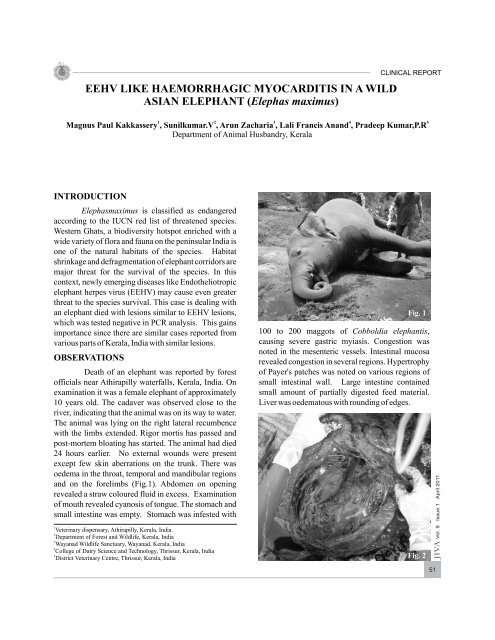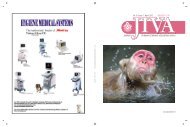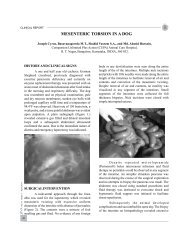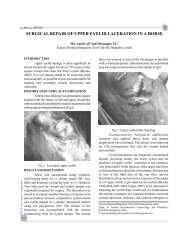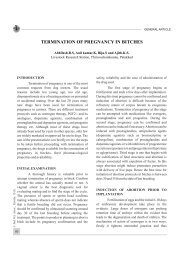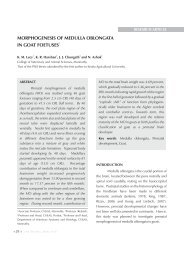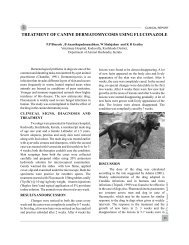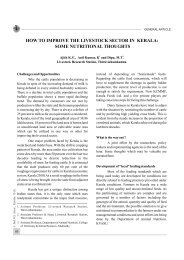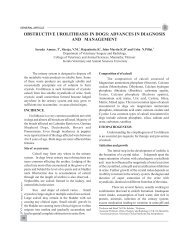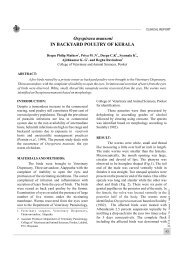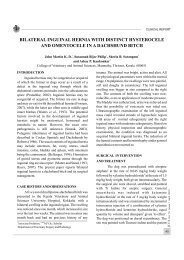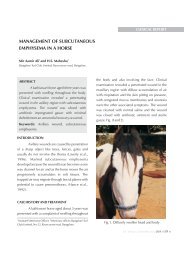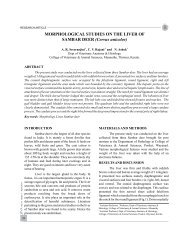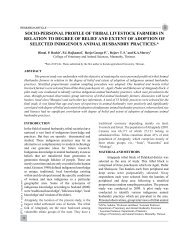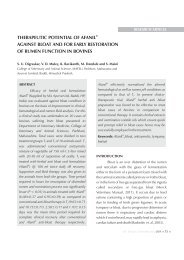elephas maximus - Jivaonline.net
elephas maximus - Jivaonline.net
elephas maximus - Jivaonline.net
You also want an ePaper? Increase the reach of your titles
YUMPU automatically turns print PDFs into web optimized ePapers that Google loves.
EEHV LIKE HAEMORRHAGIC MYOCARDITIS IN A WILD<br />
ASIAN ELEPHANT (Elephas <strong>maximus</strong>)<br />
CLINICAL REPORT<br />
1 2 3 4 5<br />
Magnus Paul Kakkassery , Sunilkumar.V , Arun Zacharia , Lali Francis Anand , Pradeep Kumar,P.R<br />
Department of Animal Husbandry, Kerala<br />
INTRODUCTION<br />
Elephas<strong>maximus</strong> is classified as endangered<br />
according to the IUCN red list of threatened species.<br />
Western Ghats, a biodiversity hotspot enriched with a<br />
wide variety of flora and fauna on the peninsular India is<br />
one of the natural habitats of the species. Habitat<br />
shrinkage and defragmentation of elephant corridors are<br />
major threat for the survival of the species. In this<br />
context, newly emerging diseases like Endotheliotropic<br />
elephant herpes virus (EEHV) may cause even greater<br />
threat to the species survival. This case is dealing with<br />
an elephant died with lesions similar to EEHV lesions,<br />
which was tested negative in PCR analysis. This gains<br />
importance since there are similar cases reported from<br />
various parts of Kerala, India with similar lesions.<br />
OBSERVATIONS<br />
Death of an elephant was reported by forest<br />
officials near Athirapilly waterfalls, Kerala, India. On<br />
examination it was a female elephant of approximately<br />
10 years old. The cadaver was observed close to the<br />
river, indicating that the animal was on its way to water.<br />
The animal was lying on the right lateral recumbence<br />
with the limbs extended. Rigor mortis has passed and<br />
post-mortem bloating has started. The animal had died<br />
24 hours earlier. No external wounds were present<br />
except few skin aberrations on the trunk. There was<br />
oedema in the throat, temporal and mandibular regions<br />
and on the forelimbs (Fig.1). Abdomen on opening<br />
revealed a straw coloured fluid in excess. Examination<br />
of mouth revealed cyanosis of tongue. The stomach and<br />
small intestine was empty. Stomach was infested with<br />
1<br />
Veterinary dispensary, Athirapilly, Kerala, India.<br />
2<br />
Department of Forest and Wildlife, Kerala, India<br />
3<br />
Wayanad Wildlife Sanctuary, Wayanad, Kerala, India<br />
4<br />
College of Dairy Science and Technology, Thrissur, Kerala, India<br />
5<br />
District Veterinary Centre, Thrissur, Kerala, India<br />
Fig. 1<br />
100 to 200 maggots of Cobboldia elephantis,<br />
causing severe gastric myiasis. Congestion was<br />
noted in the mesenteric vessels. Intestinal mucosa<br />
revealed congestion in several regions. Hypertrophy<br />
of Payer's patches was noted on various regions of<br />
small intestinal wall. Large intestine contained<br />
small amount of partially digested feed material.<br />
Liver was oedematous with rounding of edges.<br />
Fig. 2<br />
JIVA Vol. 9 Issue 1 April 2011<br />
51
CLINICAL REPORT<br />
JIVA Vol. 9 Issue 1 April 2011<br />
Lungs exhibited diffuse haemorrhage in the<br />
parenchyma. Heart on examination revealed<br />
ecchymotichaemorrhage on the myocardium.<br />
Endocardium revealed severe haemorrhage with<br />
severe involvement of cardiac valves (Fig.2).<br />
Generalised myocardial oedema with myocarditis<br />
was present. Samples were collected from heart,<br />
liver and lung on ice for DNA extraction and PCR<br />
analysis. The result of PCR analysis to detect<br />
Endotheliotropic Elephant Herpes Viral DNA<br />
performed at Wildlife Disease Research Laboratory,<br />
Wayanad was negative.<br />
DISCUSSION<br />
Haemorrhagic myocarditis with pericardial<br />
effusion is the typical symptom of EEHV. Other<br />
symptoms observed in EEHV infection are<br />
haemorrhage throughout the peritoneal cavity,<br />
hepatomegally, cyanosis of the tongue, intestinal<br />
haemorrhage and ulceration. Early clinical signs of<br />
EEHV infection are oedematous swelling of head,<br />
neck and thoracic limbs and cyanosis of tongue<br />
starting from the tip of tongue (Richman et al., 2000).<br />
In the present case peritoneal haemorrhage was<br />
absent, but peritoneal cavity was filled with very<br />
large quantity of straw coloured fluid as reported by<br />
Garner et al. (2009).<br />
Elephant stomach bot flies (Cobboldia<br />
elephantis) have been reported in Asian elephant<br />
population by many scientists (Easwaran et al., 2002<br />
and Sanyathitiseree et al., 2009). In this case there<br />
were too many larvae on the stomach wall causing<br />
gastric myiasis. Adult flies lay eggs near the mouth.<br />
The larvae hatch and develop in the mouth cavity and<br />
later move to stomach. All three stages of larvae may<br />
be observed on stomach wall. Matured third stage<br />
larvae exit from the mouth and drop to the ground to<br />
pupate (Fowler and Mikota, 2006). .<br />
African elephants act as reservoir for herpes virus<br />
and which causes disease in two elephant species.<br />
Death in EEHV is a result of cardiac failure resulting<br />
from herpes virus induced capillary injury with<br />
extensive myocardial haemorrhage and oedema. In<br />
most animal species the herpes virus are<br />
epitheliotropic or a predilection for nervous tissue. In<br />
case of EEHV the virus multiplies in vascular<br />
endothelium and forms amphophilic to basophilic<br />
intranuclear inclusion bodies which may be considered<br />
as pathognomonic of the disease syndrome.<br />
CONCLUSION<br />
In the present case lesions described are similar to<br />
lesions of EEHV, but PCR analysis was negative for<br />
viral DNA. EEHV if spreads to the wild population of<br />
Asia, it will devastate the already fragile and critically<br />
endangered Asian elephant population. There need to<br />
be a better understanding of the epidemiology of EEHV<br />
in wild elephant population, so that a better control<br />
strategy may be devised, which is totally lacking today.<br />
REFERENCES<br />
Easwaran, K.R., Ravindran, R. and Pillai, K.M.<br />
(2002).Parasitic infestation of some wild animals at<br />
Thekkady in Kerala.Zoos'print J. 18: 1030.<br />
Ehlers, B., Burkhardt, S.,Goltz, M., Bergmann, V., Ochs, A.,<br />
Weiler, H. and Hentschke, J. (2001). Ge<strong>net</strong>ic and<br />
ultrastructural characterization of a European isolate<br />
of the fatal Endotheliotropic elephant herpes virus. J.<br />
General Virol. 82: 475-482.<br />
Ehlers, B., Dural, G., Marschall, M., Schregal, V., Goltz, M.<br />
and Hentschke, J. (2006). Endotheliotropic elephant<br />
herpes virus, the first beta herpes virus with a<br />
thymidine kinase gene. J. General Virol. 87: 2781-<br />
2789.<br />
Fowler, M.E. and Mikota, S.K. (2006).Elephant biology,<br />
medicine and surgery. Blackwell Publishing.p.166.<br />
Richman, L.K., Montali, R.J., Cambre, R.C., Schmitt, D.,<br />
Hardy, D., Hildbrandt, T., Bengis, R.G., Hamzech,<br />
F.M., Shahkolahi, A. and Hayward, G.S. (2000). J.<br />
Wildlife Dis. 36: 1-12.<br />
Sanyathitiseree, P., Pinyopanuwat, N., Pharuk, J., Prasitiphol,<br />
S., Yabantoong, N., Mueangthong, N., Losanyaluk, B.<br />
and Kasorandorkbua, C. 2009. Prevalence of stomach<br />
bot flies in a wild elephant from Kanchanaburi<br />
province. Kasetsart Veterinarians 19: 42-47.<br />
52


